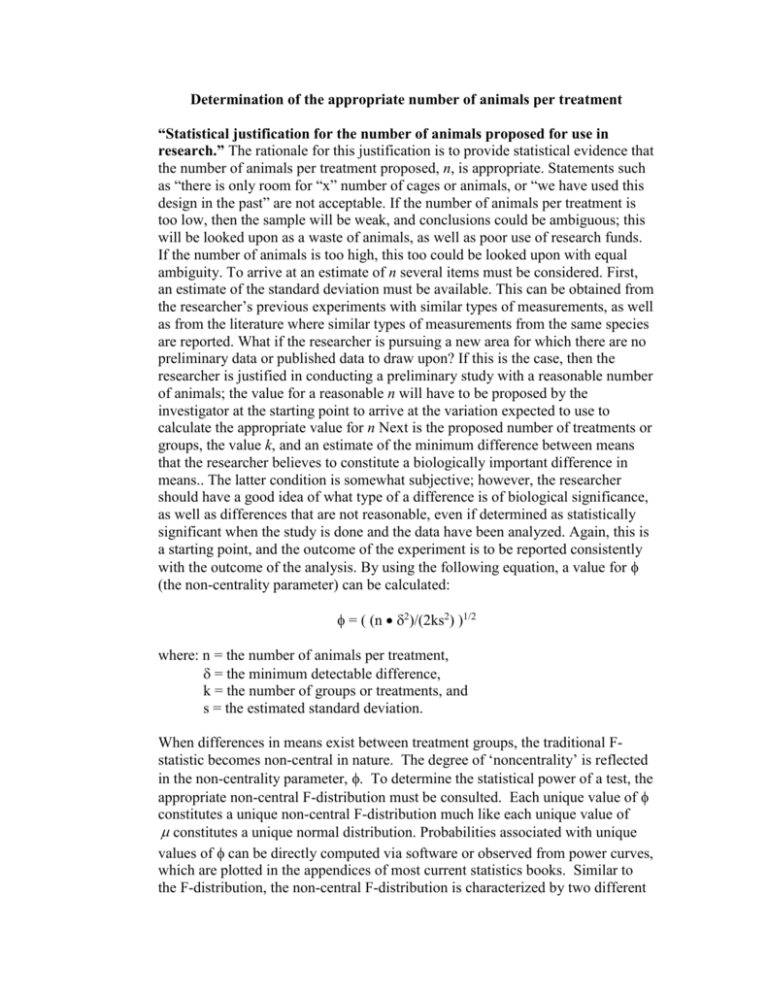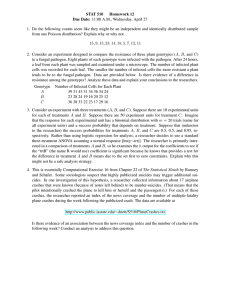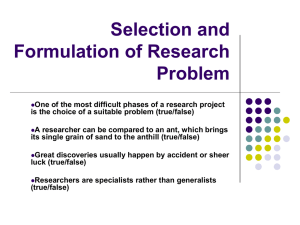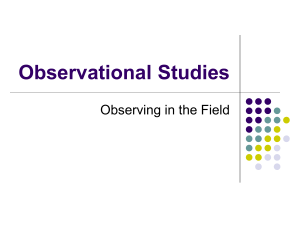ESTIMATION OF THE NUMBER OF ANIMALS REQUIRED
advertisement

Determination of the appropriate number of animals per treatment “Statistical justification for the number of animals proposed for use in research.” The rationale for this justification is to provide statistical evidence that the number of animals per treatment proposed, n, is appropriate. Statements such as “there is only room for “x” number of cages or animals, or “we have used this design in the past” are not acceptable. If the number of animals per treatment is too low, then the sample will be weak, and conclusions could be ambiguous; this will be looked upon as a waste of animals, as well as poor use of research funds. If the number of animals is too high, this too could be looked upon with equal ambiguity. To arrive at an estimate of n several items must be considered. First, an estimate of the standard deviation must be available. This can be obtained from the researcher’s previous experiments with similar types of measurements, as well as from the literature where similar types of measurements from the same species are reported. What if the researcher is pursuing a new area for which there are no preliminary data or published data to draw upon? If this is the case, then the researcher is justified in conducting a preliminary study with a reasonable number of animals; the value for a reasonable n will have to be proposed by the investigator at the starting point to arrive at the variation expected to use to calculate the appropriate value for n Next is the proposed number of treatments or groups, the value k, and an estimate of the minimum difference between means that the researcher believes to constitute a biologically important difference in means.. The latter condition is somewhat subjective; however, the researcher should have a good idea of what type of a difference is of biological significance, as well as differences that are not reasonable, even if determined as statistically significant when the study is done and the data have been analyzed. Again, this is a starting point, and the outcome of the experiment is to be reported consistently with the outcome of the analysis. By using the following equation, a value for (the non-centrality parameter) can be calculated: = ( (n 2)/(2ks2) )1/2 where: n = the number of animals per treatment, = the minimum detectable difference, k = the number of groups or treatments, and s = the estimated standard deviation. When differences in means exist between treatment groups, the traditional Fstatistic becomes non-central in nature. The degree of ‘noncentrality’ is reflected in the non-centrality parameter, . To determine the statistical power of a test, the appropriate non-central F-distribution must be consulted. Each unique value of constitutes a unique non-central F-distribution much like each unique value of constitutes a unique normal distribution. Probabilities associated with unique values of can be directly computed via software or observed from power curves, which are plotted in the appendices of most current statistics books. Similar to the F-distribution, the non-central F-distribution is characterized by two different degree of freedom components (one for the numerator and one for the denominator). Degrees of freedom are calculated in the numerator as the specified number of treatments (1 = number of groups – 1) and for the denominator as (2 = total number of animals – number of groups). Using and the appropriate degrees of freedom, the researcher can easily arrive at a given power (usually 1 - = 0.9) for a preferred alpha level (usually = 0.05). Additionally, the software package, MINITAB, which should be available through the UW network, has a feature that will calculate the appropriate value for n for simple designs. The Research Office web page link to ACUC protocols forms also contains a web link to a program that will calculate n for more complex models; however, the interaction of a statistician is advised because the program requires a more in depth understanding of the various models. Generally, the collaboration of a statistician is advised so that the researcher can determine the most appropriate design before the experiments are begun. Three common scenarios are typical for most research studies. First, a given design is to be applied to evaluate if a treatment elicits a difference when compared to other treatments or a control (hypothesis to be tested is treatment will increase/decrease a given measurement compared with a control or to other treatments). If preliminary data are available, the appropriate number of animals can be estimated, and the justification described directly. Second, there are no data. In this situation, a preliminary study is conducted to evaluate n Third, the hypothesis to be tested is that the treatment will not elicit a difference. For the third scenario, the same approach should be taken in that the researcher should decide what level of difference between the means will constitute a biologically meaningful difference, and go from there. For this case, a “positive” experiment will result in treatment means that do not differ more than the minimum needed with the number of animals used per treatment determined “apriori.”











